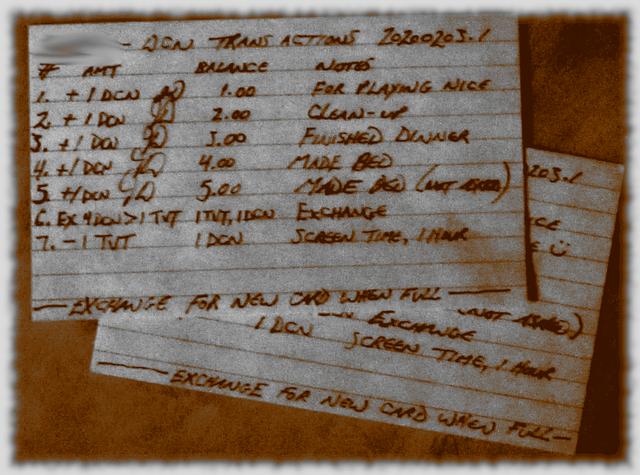Rules shmules: A homemade "cryptocurrency" exchange game for kids to incentivize self-governance
I've often felt the frustration of being caught between wishing my kids had more of a respect for rules, and the knowledge that kids tend to rebel against rules, especially those set down by parents.
Over time I've done so much squawking at my progeny to Do this! or Don't do that!, and now I'm simply fresh out of squawk. They're generally well-behaved, and more or less respect the rules set down by their parents and other authority figures--however, like any kids, they have their flare-ups and lapses.
Seeing as how I'm now squawkless, I've been thinking that trying to enforce rules from above was the wrong approach all along, and that maybe what I've been needing is a system to motivate my kids to make better choices in those areas where they are sometimes lacking.
At the same time, I have been involved in the world of blockchain technology in one form or another since mid-2018, and so it comes as no surprise (to me, in retrospect) that if you hand a cryptocurrency enthusiast a social problem to resolve, he'll come up with a cryptocurrency-based solution.
Enter the homemade "crytpocurrency" exchange game for kids
The solution I came with is a non-electronic, non-blockchain "cryptocurrency" exchange game in which all transactions for each child are initially recorded by hand on a 3"x 5" index card (because I'm trying to reduce screen time and encourage penmanship), including the transaction number, amount being earned (in DCN, our in-house token), traded, or spent, my initials (as authorization), the resulting balance after each transaction, and a brief note describing the reason for the transaction. Following that sequence, the second line from my oldest child's first transaction card was rendered like this:
2. +1.00 DCN JD 2.00 HOMEWORK DONE

In practice, this system strikes me as being more of a Local Exchange Trading System (LETS) than an According to Hoyle</> cryptocurrency, which by definition is digital in nature. Nevertheless, the inspiration for this system was the world of blockchain-based cryptocurrencies such as Ethereum, Tron TRX, or even Steem, where the currency itself can be the basis for other cryptocurrencies. In this case, even within my pen-and-paper system, I have a main currency, which can be exchanged for three different 'reward tokens'. (As far as I know, the LETS model doesn't involve multiple currencies.)
The main currency
Under my own implementation of this new system, Daddy Coin (abbreviated as "DCN" in my ledger) is the main currency, or direct "reward for work" token, if you will. It is the initial 'coin' my children earn for completing tasks or demonstrating good behavior and respectful conduct. This includes completing their homework, participation and good behavior at extracurricular activities, finishing what's on their plate at dinner time, and respectful conduct overall, among others.
Generally, one DCN is awarded for the completion of any given task, such as chores. (If they do their chores without having to be asked, then they earn double the usual rate.)
Reward Tokens
Once some Daddy Coins are accumulated, holders can then exchange some or all of them for reward tokens, which in this household numbers three so far:
TV Time Tokens (TVT): Payable in screen time (TV or computer). One DCN can be exchanged for 0.25 TVT, which entitles the holder to 15 minutes of screen time. One full TVT will get them an hour of brain rot. Any TVT that is banked (or "staked", in cryptocurrency lingo) will accrue 10% interest per day, so as to provide an incentive to delay gratification. Banked TVT, including interest income, can be converted back into DCN, and then exchanged for one of the reward tokens below.
Treat (TRT): Payable in candies or snacks from a store, according to the fiat value of accumulated tokens. One DCN can be traded for 0.125 TRT. One TRT (or eight DCN) has a fiat value (in Canadian dollars) of $1.50.
Toy Tokens (TOY): Payable in toys, puzzles or books from a store, according to the fiat value of accumulated tokens. As with the exchange rate for TRT, one DCN can be traded for 0.125 TOY.
So far, so good...
It took me at least 20 minutes to explain the system to my kids, and once they saw me writing out the first transaction on each of their cards (for playing nice with each other), they really warmed up to the idea and were raring to get some more points on the board, as it were. (This is the first time in recent memory that they volunteered to make their beds without having been asked. As per our agreement, of course, this earned them twice the usual rate.)
I'm hoping the novelty of this system doesn't wear off too soon, and that my kids will continue to push themselves to earn more 'coins', while also conditioning themselves to continue making better choices long after this behavior modification game becomes a distant childhood memory.
In the end, it's not really about making them follow rules, but about teaching them that rules are incidental when they exercise personal self-governance.
The first draft and initial formatting of this article was done using the 9front operating system and the Acme text editor.